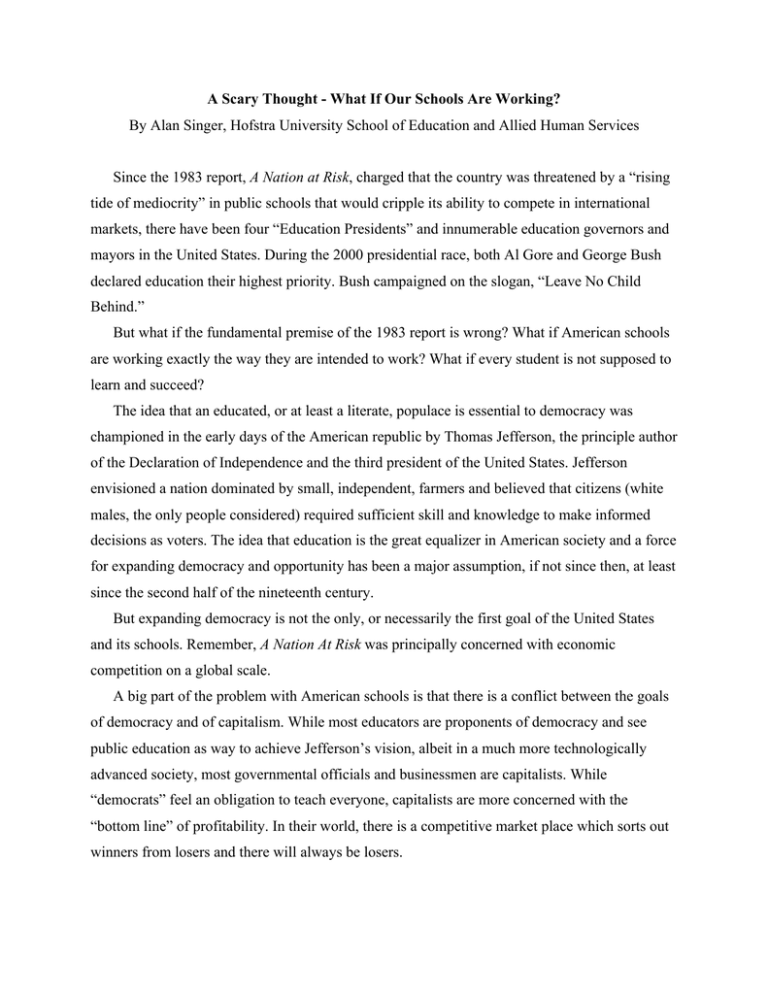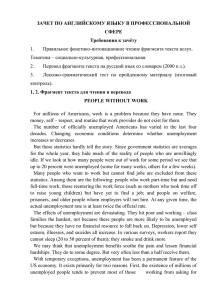A Scary Thought - What If Our Schools Are Working?
advertisement

A Scary Thought - What If Our Schools Are Working? By Alan Singer, Hofstra University School of Education and Allied Human Services Since the 1983 report, A Nation at Risk, charged that the country was threatened by a “rising tide of mediocrity” in public schools that would cripple its ability to compete in international markets, there have been four “Education Presidents” and innumerable education governors and mayors in the United States. During the 2000 presidential race, both Al Gore and George Bush declared education their highest priority. Bush campaigned on the slogan, “Leave No Child Behind.” But what if the fundamental premise of the 1983 report is wrong? What if American schools are working exactly the way they are intended to work? What if every student is not supposed to learn and succeed? The idea that an educated, or at least a literate, populace is essential to democracy was championed in the early days of the American republic by Thomas Jefferson, the principle author of the Declaration of Independence and the third president of the United States. Jefferson envisioned a nation dominated by small, independent, farmers and believed that citizens (white males, the only people considered) required sufficient skill and knowledge to make informed decisions as voters. The idea that education is the great equalizer in American society and a force for expanding democracy and opportunity has been a major assumption, if not since then, at least since the second half of the nineteenth century. But expanding democracy is not the only, or necessarily the first goal of the United States and its schools. Remember, A Nation At Risk was principally concerned with economic competition on a global scale. A big part of the problem with American schools is that there is a conflict between the goals of democracy and of capitalism. While most educators are proponents of democracy and see public education as way to achieve Jefferson’s vision, albeit in a much more technologically advanced society, most governmental officials and businessmen are capitalists. While “democrats” feel an obligation to teach everyone, capitalists are more concerned with the “bottom line” of profitability. In their world, there is a competitive market place which sorts out winners from losers and there will always be losers. Capitalism continually produces major dislocations and injustices. A lot of small investors went broke along with the Dot.coms. Hard working people were hurt by the scandals affecting Enron and Arthur Anderson. In this system, a full employment economy is defined as five percent of the workforce out-of-work at any given time; in many inner-city African American communities full employment translates into nearly half the working population unemployed or threatened by unemployment during the course of a year. In a society where education is organized to achieve capitalist goals, mass public education has two primary purposes. It sorts people out, determining who will be recruited to the elite, learn and succeed, who will receive enough basic training to make an acceptable living, and who will be pushed to the margins of society. It does this through an elaborate system that includes racially and economically segregated school districts that receive different levels of funding, magnet, private and charter schools that sift-off the highest performing or most cooperative students, and rigorous testing and tracking within schools. In order to do this type of sorting successfully, American society and its schools must convince parents and students to accept the legitimacy of a system where social and economic rewards are so unequally divided and many people are considered superfluous. Even though a sizeable percentage of the population is predestined to fail, young people are repeatedly taught in school, and generally come to believe, that failure is their own fault. Neither the economy, or the school system works smoothly. Sometimes teachers, parents, students and even whole communities mistakenly come to believe that education is supposed to be for everybody. Usually in these cases the squeaky wheel gets the grease - a grant, a remedial program, or a new school - but the system goes unchanged. If the system overproduces a particular “product,” market forces go into play. Demand for groups of workers and wages drop. People who worked hard for decades to become skilled professionals, who borrowed tens of thousands of dollars and did all of the right things are left to bear individual responsibility for their “poor economic choices.” Sometimes the education system fails to anticipate new economic directions and there are shortages in particular skilled areas. In these cases, globalization kicks in to solve the problem. Instead of investing billions of dollars in programs to educate large numbers of people when only a few thousand are needed, jobs can be exported overseas or technicians, doctors, mechanics, teachers and even life-guards can be imported from other countries where the cost of training are less. Depending on need or political contingencies, they can enter s temporary workers or even as permanent residents and potential citizens. A lot of fuss is made by politicians and some educators about poor test scores and the need to raise academic standards in the United States. But they rarely ask the key question: why aren’t all students doing well? More than a century ago, Emile Durkheim, a French sociologist, rejected the idea that education could be the force to solve society’s problems. Durkheim believed that education could be “reformed only if society itself” was reformed. He argued that education was “only the image and reflection of society. It imitates and reproduces the latter. . . ; it does not create it.” I think Durkheim is saying that we have the schools we have -- not because teachers are bad or there is something wrong with children or their parents, but because it serves the interests of powerful forces in our society not to educate some children and to have teachers, parents and children blame each other for the problems. If Emile Durkheim is correct, our society has the school system it deserves. Denouncing the poor quality of education is like blaming a mirror because you do not like your reflection. Blaming schools, while exempting our social system from scrutiny, allows those who support the status quo to propose relatively inexpensive, but ultimately ineffective, solutions to the problems affecting education. Instead of spending money to lower class size, build new, safe, welcoming schools for all children, enhance the development of teachers throughout their careers, and support research on promoting learning, they vote to raise standards, reshuffle curriculum content, create new tests, and demand fool-proof teacher certification criteria. Few people ask what will happen in communities where 80% of the students who complete high school are unable to earn diplomas. Can anything be done to change our schools and society and eliminate some of the gross inequalities? I am not sure. But a first step is to admit that the problem is not that schools are failing. Unfortunately, they are working exactly the way they are designed to work. According to the U.S. Bureau of Labor Statistics, the unemployment rate held at 4.2 percent in February, 2001. The United States government considers this a period of “full employment” and has taken steps to hold down wages and raise the unemployment rate. Even though they call it “full employment”, there have been large job losses in manufacturing, where employment declined by 94,000. However, employment gains in several other industries, including services, accounted for the net increase in payroll employment. Both the number of unemployed persons (5.9 million) and the unemployment rate (4.2 percent) were essentially unchanged in February. The jobless rates for most of the major worker groups--adult men (3.5 percent), adult women (3.7 percent), teenagers (13.6 percent), whites (3.7 percent), and Hispanics (6.3 percent)--were little changed from January. The unemployment rate for blacks declined to 7.5 percent, the same level as in the last quarter of 2000. The unemployment rate for young Black men ages 16-19 who were actively seeking full-time work was over 30%. Total employment was essentially unchanged at 135.8 million, seasonally adjusted, in February. The civilian labor force, at 141.8 million persons, also was little changed over the month. The labor force participation rate--the proportion of the population age 16 and older who are either working or looking for work--edged down by 0.1 percentage point to 67.2 percent, still relatively high by historical standards. About 1.3 million persons (not seasonally adjusted) were marginally attached to the labor force in February, the same as a year earlier. These people wanted and were available to work and had looked for a job sometime in the prior 12 months. They were not counted as unemployed, however, because they had not actively searched for work in the 4 weeks preceding the survey. The number of discouraged workers was 289,000 in February, about the same as a year earlier. Discouraged workers, a subset of the marginally attached, were not currently looking for work specifically because they believed no jobs were available for them. Many unemployed people are in and out of work. The number of people unemployed at some time during the year is probably double the number of people unemployed at any one time. That means that the percentage of Black people who lose a job during the year is about 15%. This only includes people actively looking for work, people who are not working part-time and people who are not full-time students. If we add discouraged workers and people who would work fulltime or leave school if they could get a job, probably a third of the adult Black population of the United States could be counted as unemployed at some point during the year. This is at a time when the United States government says there is full employment and has taken steps to hold down wages and raise the unemployment rate. Outsourcing of jobs. Schools sort and prepare students to accept failure is their own when it is built into the system. Just as it is cheaper to important steel than to produce, to assemble overseas, it is cheaper to important technicians and trained workers than to educate American population. If people understood that unemployment was built into the system and that Blacks and other minorities were targeted they would be less willin to accept. If they understood that school failure plays the role of justifying, they would be unwilling to accept. This is a system that benefits from racial destinction, easier to justify when beneficiaries are in a majority and primary victims only constitute 15to 20%. But is exists independently of racism. This being the case, I believe there are still real possibilities for improving public education. American educational ideology is inconsistent, valuing individualism, competition and materialism, but also citizenship, democracy, and equality. Teachers can take advantage of this inconsistency to create democratic classroom communities where students learn to think critically, provide leadership and care about others. For me, the crucial players in the struggle to transform schools (and society) are our students. If they experience concern and democracy in schools and learn to think critically about the world, they can become powerful agents for change. It is our job as teachers, a very difficult job, to find ways to help them. In addition, teachers can build on the strengths of students while acknowledging weaknesses. Strategies to promote the love of learning must take both into account. Poverty, alienation and discrimination have had a devastating impact on many communities in the United States. What young person could emerge out of these communities, and certainly out of many of our public schools, without some educational deficits? This is why teachers cannot ignore the social context of learning. As a high school teacher, I tried to connect with every student in the room, even when I realized it was not always possible; there were too many complicating factors in the lives of my students. What kept me going may have been obstinacy, but it was also the realization that I could not predict which students would respond, so the only way I could reach some of the students, was to try to reach every one of them. I think conservative politicians and educators made a strategic error in their campaign for higher educational standards, and that their mistake opens up space for legal challenges to unequal school funding and for organizing the public to fight for a more equitable school system and society. State legislatures and courts generally endorse school systems that permit social inequality. National and state standards, by raising the minimum for acceptable school performance and by providing a new definition of a “sound basic education,” make every school system subject to legal review. Teachers, parents and our students can be major contributors to campaigns that insist that our school systems obey the law. Many new teachers are frightened of being perceived of as activists or even of being seen as having a point of view. Some argue that they will wait until they have tenure before they express their views. However, my experience is that if you are afraid to speak out before you have tenure, you will not speak out later. School districts always have treats to offer or withhold, better rooms and equipment, advanced placement classes, extracurricular pay, or administrative assignments, so there is always another reason to remain silent. As a teacher, you will have to decide whether you are going to remain silent, join those who blame parents, children and other teachers, or become involved in the struggle to educate all children. None of us are born immune from the fear of losing a job or the prejudices that infect our society. But if teachers face up to who we are, and examine our society, attitudes and behavior with open eyes, we can overcome our limitations and help to change the world. The issue is whether we will hold to a Jeffersonian or Hamiltonian ideal in schools. The problem is not testing and standards, but that we may not be able to have both. Alan Singer is an historian and a teacher educator at Hofstra University, Hempstead, New York. The idea that an educated, or at least a literate, populace is essential to democracy was supposedly championed in the early days of the American republic by Thomas Jefferson, the principle author of the Declaration of Independence and the third president of the United States. But Jefferson only proposed three years of free education for all non-slave children. He envisioned that most white males (the only people considered) would be small, independent, farmers and only required sufficent skill and knowledge to make informed decisions as voters. Only the economic and academic elite would receive any form of higher education.





